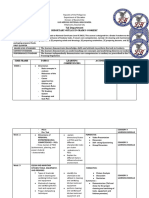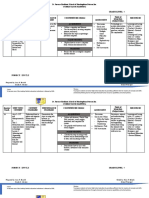100%(1)100% found this document useful (1 vote)
448 viewsModule 2 - Environment & Market
This document provides guidance on generating and selecting entrepreneurial business ideas. It discusses examining existing goods/services to identify improvement opportunities, understanding current and future customer needs, how needs are currently being met or not met, available local resources, and gaining ideas from publications. The document advises generating many initial ideas and then screening them through multiple stages to narrow options down to the most promising business concept to pursue.
Uploaded by
Gilbert BautistaCopyright
© © All Rights Reserved
Available Formats
Download as DOCX, PDF, TXT or read online on Scribd
100%(1)100% found this document useful (1 vote)
448 viewsModule 2 - Environment & Market
This document provides guidance on generating and selecting entrepreneurial business ideas. It discusses examining existing goods/services to identify improvement opportunities, understanding current and future customer needs, how needs are currently being met or not met, available local resources, and gaining ideas from publications. The document advises generating many initial ideas and then screening them through multiple stages to narrow options down to the most promising business concept to pursue.
Uploaded by
Gilbert BautistaCopyright
© © All Rights Reserved
Available Formats
Download as DOCX, PDF, TXT or read online on Scribd
You are on page 1/ 12
18
Technology and Livelihood Education
Entrepreneurship
Module 2: Environment and Market
One of your greatest dreams in life is to become a successful entrepreneur. As a
person, you are capable of developing your character and personality and how to
respond to some business challenges and opportunities. You can make things happen
by identifying the opportunities around you. You may ask yourself these questions:
What do people need? What products and services are available in the market today?
Can they be improved? How are they made or delivered? Can things be done better?
cheaper? faster? cleaner? Can a product which is used for specific purpose be also
used for some other purposes?
You slowly find answers to these questions as you decide to do the first step in
launching a business enterprise. Be cautious however, that you should develop a habit
of identifying opportunities around you. Only then, you will find the activity both exciting
and easy.
19
EXPLORE your Understanding
Essential Question
How does one select an entrepreneurial activity?
Content Standard
- The learner demonstrates understanding of environment and market that relates with
the career choice.
Performance Standard
- The learner formulates a business idea based on the analysis of the environment
and market
Guide Questions:
1. How does one determine the product to be produced or services to be offered and
delivered to the target market or customers in a particular community?
2. How does one select an entrepreneurial activity?
3. How can one respond effectively to a business enterprise?
Hello there! Are you ready to assess yourself if you are ready to generate
potential business ideas? Lets try by answering the succeeding pre-
assessment.
Pre-assessment
1. The following are examples of peoples basic needs, except:
a. Recreation
b. Clothing
c. Shelter
d. Food
20
2. Which of the following should be considered first by a prospective entrepreneur
in choosing the right location for his/her store?
a. Types of merchandise
b. Access of the target customers
c. The attractiveness of the store layout
d. The prevailing prices of goods in the area
3. Thong plans to put a digi-print studio in their locality. Which of the following
will help him determine a successful plan for setting up of his business?
a. Survey of consumer associations
b. Checking for similar business to avoid competition
c. Getting feedback on the quality of service
d. Conduct a SWOT analysis
4. Ceasar studies the population in his immediate community. He is doing this to
a. identify his would be suki.
b. predict his biggest buyer.
c. select his favorite costumers.
d. determine whom to sell his product or service.
5. When an entrepreneur improves and alter products to make it more appealing to
target consumers, he/she is doing an -------- of the product.
a. alteration
b. invention
c. innovation
d. improvisation
Lesson 1Needs and Wants of People
Everyone has his or her own needs and wants. However, people have different
concepts of needs and wants. Needs in business are important things that every
individual cannot do without in a society. These include:
1. Basic commodities for consumption
2. Clothing and other personal belongings,
3. Shelter, sanitation and health
4. Education and relaxation
21
Basic needs are essential to every individual so he/she may be able to live with
dignity and pride in the community of people. These needs can obviously help you
generate business ideas.
Wants are desires, luxury and extravagance that signify wealth and an expensive
way of living. Wants or desires are considered above all the basic necessities of life.
Some examples are the eagerness or the passion of every individual which are non-
basic needs like; fashion accessories, shoes, clothes, travelling around the world, eating
in an exclusive restaurant; watching movies, concerts, plays, having luxurious cars,
wearing expensive jewelry, perfume, living in impressive homes, and others.
Needs and wants of people are the basic indicators of the kind of business that
you may engage into because it can serve as the measure of your success. Some
other good points that you might consider in business undertakings are the kind of
people, their needs, wants, lifestyle, culture and tradition, and social orientation that
they belong.
Lesson 2 Generating ideas for business
Here are some ways by which you may generate possible ideas for business.
1. Examine the existing goods and services. Are you satisfied with the product?
What do other people who use the product say about it? How can it be
improved? There are many ways of improving a product from the way it is made
to the way it is packed and sold? You can also improve the materials used in
crafting the product. In addition, you introduce new ways of using the product,
making it more useful and adaptable to the customers many needs. When you
are improving the product or enhancing it, you are doing an innovation. You can
also do an invention by introducing an entirely new product to replace the old
one.
Business ideas may also be generated by examining what goods and services
are sold outside by the community. Very often, these products are sold in a form
that can still be enhanced or improved.
2. Examine the present and future needs. Look and listen to what the
customers, institution, and communities are missing in terms of goods and
services. Sometimes, these needs are already obvious and felt at the moment.
Other needs are not that obvious because they can only be felt in the future, in
22
the event of certain developments in the community. For example, a town will
have its electrification facility in the next six months. Only by that time will the
entrepreneur could think of electrically- powered or generated business such as
xerox copier, computer service, digital printing, etc.
3. Examine how the needs are being satisfied. Needs for the products and
services are referred to as market demand. To satisfy these needs is to supply
the products and services that meet the demands of the market. The term
market refers to whoever will use or buy the products or service, and these may
be people or institutions such as other businesses, establishments,
organizations, or government agencies.
There is a very good business opportunity when there is absolutely no supply to
a pressing market demand.
Businesses or industries in the locality also have needs for goods and services.
Their needs for raw materials, maintenance, and other services such as selling
and distribution are good sources of ideas for business.
4. Examine the available resources around you. Observe what materials or
skills are available in abundance in your area. A business can be started out of
available raw materials by selling them in raw form and by processing and
manufacturing them into finished products. For example, in a copra-producing
town, there will be many coconut husks and shells available as waste products.
These can be collected and made into coco rags/doormat and charcoal bricks
and sold profitably outside the community.
A group of people in your neighborhood may have some special skills that can be
harnessed for business. For example, women in the Mountain Province possess
loom weaving skills that have been passed on from one generation to the next
generation. Some communities there set up weaving businesses to produce
blankets, as well as decorative items and various souvenir items for sale to
tourists and lowland communities.
Business ideas can come from your own skills. The work and experience you
may have in agricultural arts, industrial arts, home economics, and ICT classes
will provide you with business opportunities to acquire the needed skills which
will earn for you extra income, should you decide to engage in income-generating
activities. With your skills, you may also tinker around with various things in your
spare time. Many products were invented this way.
23
5. Read magazines, news articles, and other publications on new products
and techniques or advances in technology. You can pick up new business
ideas from Newsweek, Readers Digest, Business Magazines, Go Negosyo, KAB
materials, Small- industry Journal. The Internet serves as a library where you
may browse and surf on possible businesses. It will also guide you on how to put
the right product in the right place, at the right price, at the right time.
Listing of possible businesses to set up in an area may also be available from
banks or local non-government organizations.
Lesson 3Selecting the Right Idea
Once you have embarked on identifying the business opportunities, you
will eventually see that there are many possibilities that are available for you. It
is very unlikely that you will have enough resources to pursue all of them at once.
Which one will you choose?
You have to select the most promising one from among hundreds and one
ideas. It will be good to do this in stages. In the first stage, you screen your
ideas to narrow them down to about five choices. In the next stage, trim down
the five choices to two options. In the final stage, choose between the two and
decide which business idea worth pursuing.
In screening your ideas, examine each one in terms of the following
factors:
1. How much capital is needed to put up the business?
2. How big is the demand for the product? Do many people need this product
and will continue to need it for a long time?
3. How is the demand met? Who are processing the products to meet the need
(competition or demand)? How much of the need is now being met (supply)?
4. Do you have the background and experience needed to run this particular
business?
5. Will the business be legal, not going against any existing or foreseeable
government regulation?
6. Is the business in line with your interest and expertise?
Your answers to these questions will be helpful in screening which ones
from among your many ideas are worth examining further and worth pursuing.
24
Lesson 4Environmental Scanning
There is a need to conduct environmental scanning to identity the needs
and wants of people, the niche for your business mission, and to give attention to
trends and issues. This may also serve as an evaluation of the type of the
entrepreneurial activity appropriate in the community.
Environmental scanning is defined as a process of gathering, analyzing,
and dispensing information for tactical or strategic purposes. The environmental
scanning process entails obtaining both factual and subjective information on the
business environments in which a company is operating.
Environment in the community can be viewed according to its
technological, political, economic, and social aspects. For example, in the past,
people in the community used personal computers but the transmission of
development in terms of technology was interrupted because people were not
satisfied with what they have today. They still look for the changes in their life
and the corresponding in their environment.
As a future entrepreneur, you must be well-versed in this kind of
advancement and progression of your environment particularly in technology so
as to secure the success of your future business. Always think of something new,
something novel, authentic, reinvent the existing ones, and create your new
version of goods/products, and services. For instance, your own hair straightening
is herbal, while in the other salons it is made of synthetic chemicals. This kind of
changes being made will effect the existing principles in business and industries
that can be easily adapted to the changes in producing the products/services to
meet the needs and wants of people in the community.
25
FIRM UP Your Understanding
In generating business idea, you should first identify what type of business is
suited to your business idea. You should analyze and scan the potential environment,
study the marketing practices and strategies of your competitors, analyze the Strengths,
Weaknesses, Opportunities, and the Threats in your environment to ensure that the
products/goods and services you are planning to offer will be patronized within the easy
reach by your target markets/consumers.
Bear in mind these simple rules for successful SWOT analysis.
Be realistic about the strengths and weaknesses of your business when
conducting SWOT analysis.
SWOT analysis should distinguish between where your business is today,
and where it could be in the future.
SWOT should always be specific. Avoid any grey areas.
Always apply SWOT in relation to your competition i.e. better than or
worse than your competition.
Keep your SWOT short and simple. Avoid complexity and over analysis
SWOT is subjective.
DEEPEN Your Understanding
People keep on searching for new things, new trends, and new issues.
For these reasons, an entrepreneur hurriedly responds to these needs and wants
of people.
As generations come and go, another set of new trends will come or will
exist. In order to adapt to the rapid changes in the business environment, the
existing industries need to improve their products and services. But how can you
generate business ideas with those strong competitors? There are three main
sets of decisions that you need to make - what to produce, how to produce, and
how to share or sell out the product to the market.
26
Activity 1Mini survey
Directions: Conduct a mini survey in your immediate community. Gather pertinent data
on population across age brackets as suggested in the matrix below. Opposite each
age group, indicate their probable needs and wants.
A
Activity 2 Screening business ideas
Directions: After filling out the chart above, try to list down all the probable business
opportunities which you may wish to venture in. Remember to consider the ideas and
suggestions discussed in Lesson 3. Use the suggested matrix below to indicate your
choice. Write your answers in your notebook.
Example: Selling wooden toys
Positive Factors
Negative Factors
Strengths Opportunities Weaknesses Threats
Age Bracket Population Needs Wants
Example:
5 and below
35 Toys, coloring books,
pajama
Wooden toys, glossy
coloring books, etc.
fashionable pajama
6- 10 years old
11-15 years old
16-20 years old
21-25 years old
26-35 years old
35-45 years old
46-55 years old
56-65 years old
66 and above
27
TRANSFER Of Learning
Now that, you have all the information, are you ready to test your ability to
generate your own business idea? If your answer is yes, start studying the
samplevicinity map of a community with a population of two thousand people. A
new housing project will be constructed adjacent to Daang Hari St, close to Old
Molino St., its main road. This housing project targets the homeowners who are
young couples with two kids.
In this activity, you need to answer the questions that may lead to the
generation of a probable business. Your answers to these questions will serve
as the bases in formulating your own business ideas.
1. Who do you think are your target consumers/markets?
2. Where is the most ideal location to situate your business?
3. Which products or services would appeal to your target consumers/markets?
4. Can you say that you have seized the most feasible business opportunity?
28
Post-assessment
6. The following are examples of peoples basic needs, except:
e. Recreation
f. Clothing
g. Shelter
h. Food
7. Which of the following should be considered first by a prospective entrepreneur
in choosing the right location for his/her store?
e. Type of merchandise
f. The access of the target customers
g. The attractiveness of the store layout
h. The prevailing prices of goods in the area
8. Thong plans to put a digi-print studio in their locality. Which of the following
will help him determine his plan for a success setting up of his business?
e. Survey of consumer associations
f. Checking for similar business to avoid competition
g. Getting feedback on the quality of service
h. Conduct a SWOT analysis
9. Ceasar studies the population in his immediate community. He is doing this to
e. identify his would be suki.
f. predict his biggest buyer.
g. select his favorite costumers.
h. determine whom to sell his product or service.
10. When an entrepreneur improves and alter products to make it more appealing to
target consumers, he/she is doing an -------- of the product.
e. alteration
f. invention
g. innovation
h. improvisation
29
Feedback
Pre-assessment and Post assessment
1. a
2. b
3. d
4. c
5. b
You might also like
- Achievement Cluster Planning Cluster Power Cluster: Page 1 of 1No ratings yetAchievement Cluster Planning Cluster Power Cluster: Page 1 of 11 page
- Environment and Market: Lesson 1: Needs and Wants of PeopleNo ratings yetEnvironment and Market: Lesson 1: Needs and Wants of People44 pages
- Detailed Lesson Plan (DLP) Format: 2 Tle-Cookery 9 2ND 120 Aug. 15-16, 2017No ratings yetDetailed Lesson Plan (DLP) Format: 2 Tle-Cookery 9 2ND 120 Aug. 15-16, 20171 page
- Lesson Exemplar in TLE 8-Carpentry Using The IDEA Instructional ProcessNo ratings yetLesson Exemplar in TLE 8-Carpentry Using The IDEA Instructional Process3 pages
- Republic of The Philippines Region IV - A Calabarzon Division of Calamba City Calamba City S.Y. 2018 - 2019100% (1)Republic of The Philippines Region IV - A Calabarzon Division of Calamba City Calamba City S.Y. 2018 - 20193 pages
- Ed 10 Learners Guide or Module Prelim CoverageNo ratings yetEd 10 Learners Guide or Module Prelim Coverage31 pages
- Tle - Ict - CSS: Quarter 1 - Module 0: Personal Entrepreneurial Competencies (Pecs)No ratings yetTle - Ict - CSS: Quarter 1 - Module 0: Personal Entrepreneurial Competencies (Pecs)23 pages
- Personal Entrepreneurial Competencies Pecs 2 07032018No ratings yetPersonal Entrepreneurial Competencies Pecs 2 0703201812 pages
- TLE 8 Understanding Business Environment and MarketNo ratings yetTLE 8 Understanding Business Environment and Market1 page
- Detailed Lesson Plan in TLE 7 Sto Niño Integrated School 7-Orchid100% (1)Detailed Lesson Plan in TLE 7 Sto Niño Integrated School 7-Orchid3 pages
- Junior High School Department - S.Y. 2021-2022: Saint Paul's School of Ormoc Foundation, Inc100% (1)Junior High School Department - S.Y. 2021-2022: Saint Paul's School of Ormoc Foundation, Inc5 pages
- Final TLE - AF - Aquaculture Grades 7-10 01.20.2014No ratings yetFinal TLE - AF - Aquaculture Grades 7-10 01.20.201415 pages
- Bread and Pastry Production: Technology and Livelihood EducationNo ratings yetBread and Pastry Production: Technology and Livelihood Education28 pages
- TLE8 - Plumb - Mod2 - Environment and Market - v5No ratings yetTLE8 - Plumb - Mod2 - Environment and Market - v524 pages
- Drafting Electrical and Electronic Layout, Detail0% (1)Drafting Electrical and Electronic Layout, Detail8 pages
- TLE-ICT Technical Drafting: Tools, Instruments, Materials and Equipment100% (1)TLE-ICT Technical Drafting: Tools, Instruments, Materials and Equipment24 pages
- Technical Drafting: Gilbert E. Bautista SPNHS, Tle-Ict Technical Drafting Grade 9 Teacher62% (13)Technical Drafting: Gilbert E. Bautista SPNHS, Tle-Ict Technical Drafting Grade 9 Teacher12 pages
- TLE-ICT Technical Drafting: Tools, Instruments, Materials and Equipment100% (1)TLE-ICT Technical Drafting: Tools, Instruments, Materials and Equipment24 pages
- KPRUT-What To Know... ? Procees? Reflect? Understand? and Transfer?No ratings yetKPRUT-What To Know... ? Procees? Reflect? Understand? and Transfer?19 pages
- Flybaboo - Case Study Assignment: MM5012 Business Strategy and Enterprise ModellingNo ratings yetFlybaboo - Case Study Assignment: MM5012 Business Strategy and Enterprise Modelling12 pages
- Caldwell University IFE and EFE Analysis - EditedNo ratings yetCaldwell University IFE and EFE Analysis - Edited9 pages
- Basic Swot Matrix: Internal Factors Strengths (+)No ratings yetBasic Swot Matrix: Internal Factors Strengths (+)8 pages
- Focus On Excellence!: Gordon J. Stevenson October 2014No ratings yetFocus On Excellence!: Gordon J. Stevenson October 201489 pages
- Download Study Resources for Strategic Management Planning For Domestic And Global Competition 14th Edition Pearce Test Bank100% (10)Download Study Resources for Strategic Management Planning For Domestic And Global Competition 14th Edition Pearce Test Bank55 pages
- Textile Industry: Transnational Strategic ManagementNo ratings yetTextile Industry: Transnational Strategic Management13 pages
- NQMS Presentation For Field Offices - UpdatedNo ratings yetNQMS Presentation For Field Offices - Updated58 pages
- Achievement Cluster Planning Cluster Power Cluster: Page 1 of 1Achievement Cluster Planning Cluster Power Cluster: Page 1 of 1
- Environment and Market: Lesson 1: Needs and Wants of PeopleEnvironment and Market: Lesson 1: Needs and Wants of People
- Detailed Lesson Plan (DLP) Format: 2 Tle-Cookery 9 2ND 120 Aug. 15-16, 2017Detailed Lesson Plan (DLP) Format: 2 Tle-Cookery 9 2ND 120 Aug. 15-16, 2017
- Lesson Exemplar in TLE 8-Carpentry Using The IDEA Instructional ProcessLesson Exemplar in TLE 8-Carpentry Using The IDEA Instructional Process
- Republic of The Philippines Region IV - A Calabarzon Division of Calamba City Calamba City S.Y. 2018 - 2019Republic of The Philippines Region IV - A Calabarzon Division of Calamba City Calamba City S.Y. 2018 - 2019
- Tle - Ict - CSS: Quarter 1 - Module 0: Personal Entrepreneurial Competencies (Pecs)Tle - Ict - CSS: Quarter 1 - Module 0: Personal Entrepreneurial Competencies (Pecs)
- Personal Entrepreneurial Competencies Pecs 2 07032018Personal Entrepreneurial Competencies Pecs 2 07032018
- TLE 8 Understanding Business Environment and MarketTLE 8 Understanding Business Environment and Market
- Detailed Lesson Plan in TLE 7 Sto Niño Integrated School 7-OrchidDetailed Lesson Plan in TLE 7 Sto Niño Integrated School 7-Orchid
- Junior High School Department - S.Y. 2021-2022: Saint Paul's School of Ormoc Foundation, IncJunior High School Department - S.Y. 2021-2022: Saint Paul's School of Ormoc Foundation, Inc
- Final TLE - AF - Aquaculture Grades 7-10 01.20.2014Final TLE - AF - Aquaculture Grades 7-10 01.20.2014
- Bread and Pastry Production: Technology and Livelihood EducationBread and Pastry Production: Technology and Livelihood Education
- TLE-ICT Technical Drafting: Tools, Instruments, Materials and EquipmentTLE-ICT Technical Drafting: Tools, Instruments, Materials and Equipment
- Technical Drafting: Gilbert E. Bautista SPNHS, Tle-Ict Technical Drafting Grade 9 TeacherTechnical Drafting: Gilbert E. Bautista SPNHS, Tle-Ict Technical Drafting Grade 9 Teacher
- TLE-ICT Technical Drafting: Tools, Instruments, Materials and EquipmentTLE-ICT Technical Drafting: Tools, Instruments, Materials and Equipment
- KPRUT-What To Know... ? Procees? Reflect? Understand? and Transfer?KPRUT-What To Know... ? Procees? Reflect? Understand? and Transfer?
- Flybaboo - Case Study Assignment: MM5012 Business Strategy and Enterprise ModellingFlybaboo - Case Study Assignment: MM5012 Business Strategy and Enterprise Modelling
- Focus On Excellence!: Gordon J. Stevenson October 2014Focus On Excellence!: Gordon J. Stevenson October 2014
- Download Study Resources for Strategic Management Planning For Domestic And Global Competition 14th Edition Pearce Test BankDownload Study Resources for Strategic Management Planning For Domestic And Global Competition 14th Edition Pearce Test Bank
- Textile Industry: Transnational Strategic ManagementTextile Industry: Transnational Strategic Management































































































